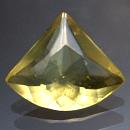 |
|
Amber
|
|
|
Discovered in perhistory; IMA status: Not Approved
|
|
Composition: |
Hydrogen |
11.18 % |
H |
99.92 % |
H2O |
|
|
Carbon |
79.94 % |
C |
|
|
|
|
Oxygen |
8.87 % |
O |
|
|
|
|
|
100.00 % |
|
99.92 % |
= TOTAL OXIDE |
|
|
|
|
Classification
|
|
|
|
|
Mineral
Classification: |
Organic Compounds
(Mineraloids)
|
|
Strunz 8th
Ed. ID:
|
9/C.01-10
|
|
|
9 : Organic Compounds
C : Resins and other compounds
01 :
Bernstein series
|
|
Related
to: |
n/a
|
|
Members
of Group: |
n/a
|
|
Varieties: |
Almashite,
Ambrosine, Bacalite, Burmite, Delatynite, Duxite, Gedanite,
Jaulingite, Jelinite, Kochenite, Munktenite, Muntenite,
Plaffeite, Rosthornite
|
|
Synonyms: |
Allingite,
Ambar, Ambroid, Ambroite, Chryselectrum, Glessum, Glesum,
Lyncurium, Lynx-stone, Succinite
|
|
|
|
|
Crystal
Data
|
|
|
|
|
Crystallography:
|
Amorphous
|
|
Crystal
Habit:
|
Amorphous.
Nodular - Tuberose forms having irregular protuberances over the surface. Pulverulent - Forms a loose, poorly-coherent powdery mass.
|
|
Twinning:
|
None
|
|
|
|
|
Physical
Properties
|
|
|
|
|
Cleavage: |
None
|
|
Fracture: |
Conchoidal
|
|
Tenacity:
|
Brittle
|
|
Moh's
Hardness: |
2.0
- 2.5
|
|
Density:
|
1.05
- 1.15 (g/cm3)
|
|
Luminescence:
|
Some
specimens may be Fluorescent.
|
|
Radioactivity:
|
Not
Radioactive
|
|
|
|
|
Optical
Properties
|
|
|
|
|
Color: |
Yellow, Colorless, Red,
Brownish Red, Brown |
|
Transparency: |
Transparent
to Translucent |
|
Luster: |
Resinous
|
|
Refractive
Index: |
1.54 Isotropic
|
|
Birefringence: |
0.00
(Isotropic) |
|
Dispersion: |
n/a
|
|
Pleochroism: |
n/a
|
|
|
|
|
Occurances
|
|
|
|
|
Geological
Setting: |
Nodules embedded in shales or sandstones and those that are washed up on
beaches. |
|
Common
Associations: |
n/a
|
|
Common
Impurities: |
Insects, spiders and their webs, annelids, frogs, crustaceans, bacteria,
amoebae, marine microfossils, wood, leaves, pollen,flowers and fruit, hair, feathers and other small organisms
|
|
Type
Locality: |
Baltic
Sea |
|
Year
Discovered: |
Prehistoric
|
|
View
mineral photos: |
Amber
Photos and Locations |
|
|
|
|
More
Information
|
|
|
|
|
|
Mindat.org
Webmineral.com
|
|
|
|
|
Amber
is a fossil resin that is a mixture of hydrocarbons, resins, succinic
acid and oils. It is the fossilized resin
of pine trees of the species Pinus succinifera
from about 30 million years ago. In order to qualify as "amber" it is not sufficient for a tree resin
merely to harden by losing its volatiles. The molecules have to
polymerize, which can take millions of years, or at least 100,000
years. The oldest amber recovered dates to the Upper Carboniferous period, about
320
million years ago. After polymerization, amber becomes significantly less soluble
in common organic solvents, and so will not become sticky if wetted with
alcohol, acetone or gasoline. Much of the material marketed as "amber"
(especially that from Colombia and Madagascar) is far too young to be
considered amber, and is in reality just dried tree resin.
Amber was named from the Arabic word anbar, which was converted to Spanish as ambar and later to amber.
Amber is mostly seen as cabochons
and is known for its inclusions of insects, pollen, leaves
and other organic debris that were trapped in the sticky
resin that oozed from pine trees millions of years ago.
Faceted Amber is not rare, but is unusual.
Amber is found in many
localities around the world. The most notable source
may be the Baltic Sea where it washes up on shore
from submerged beds. Other locations include Burma,
Dominican Republic, Romania, Russia, coal seams in Wyoming,
USA, and Venezuela.
|
|
Amber
gems for sale:
We
have not photographed our Amber gems yet. Please
check back soon.
|
|
